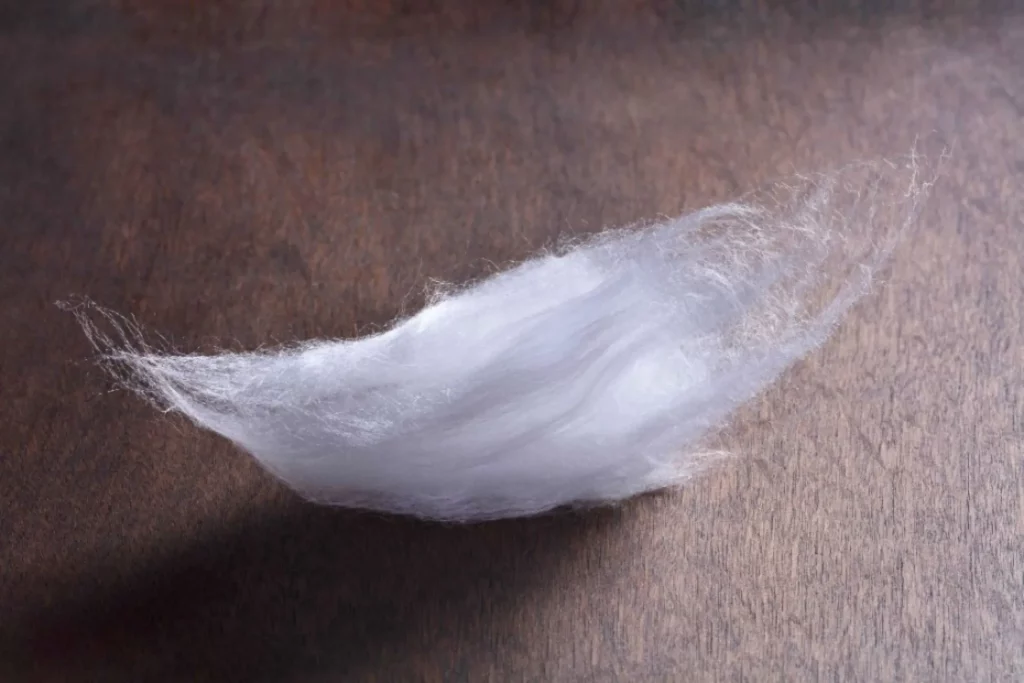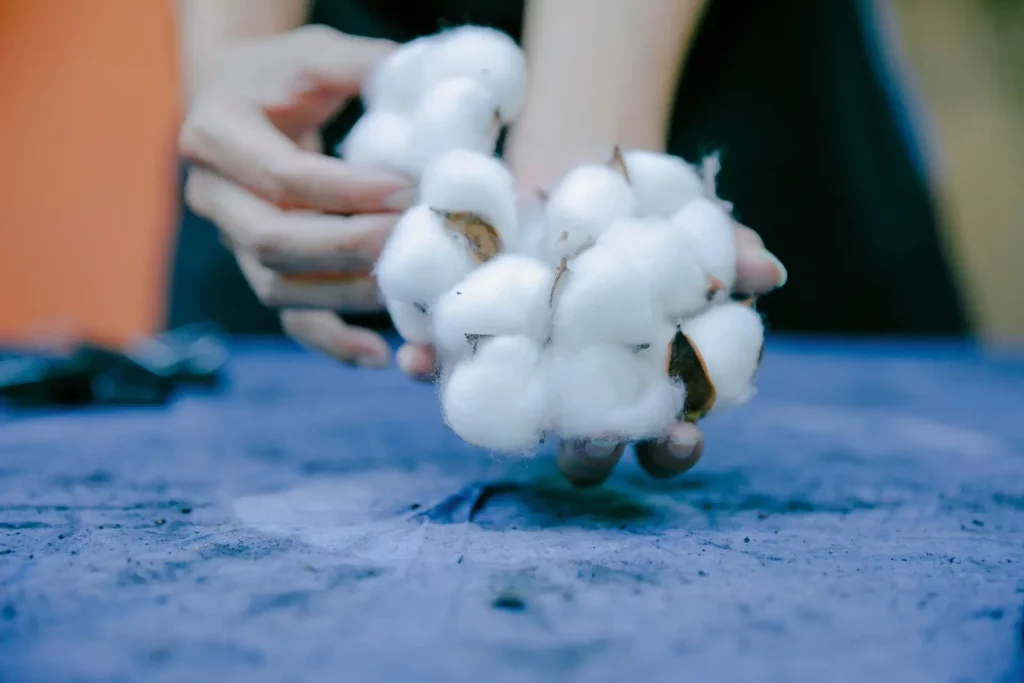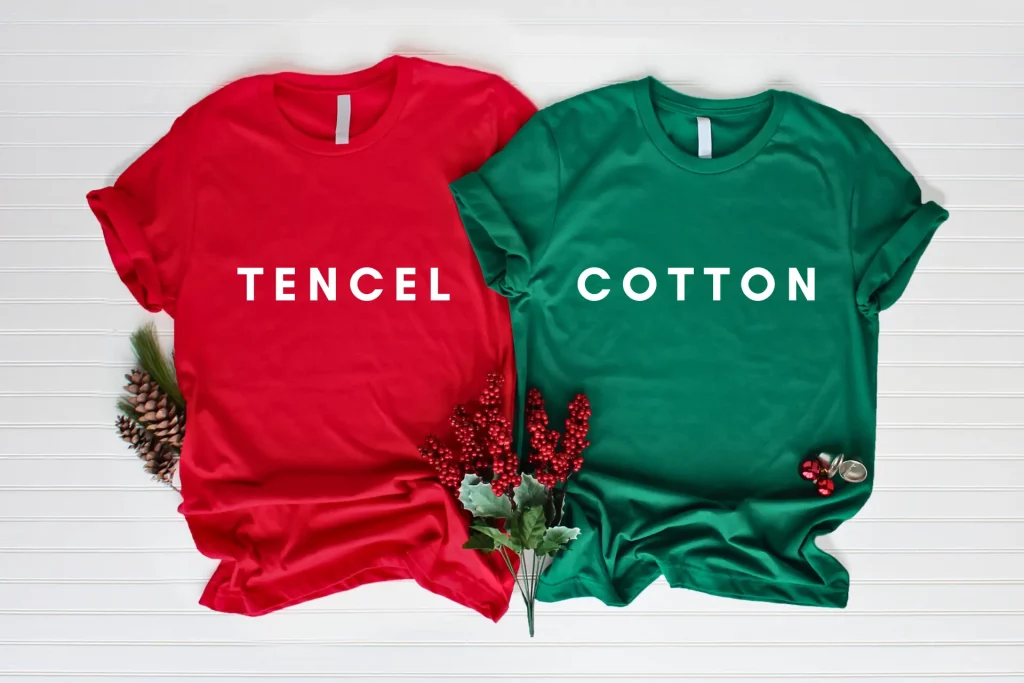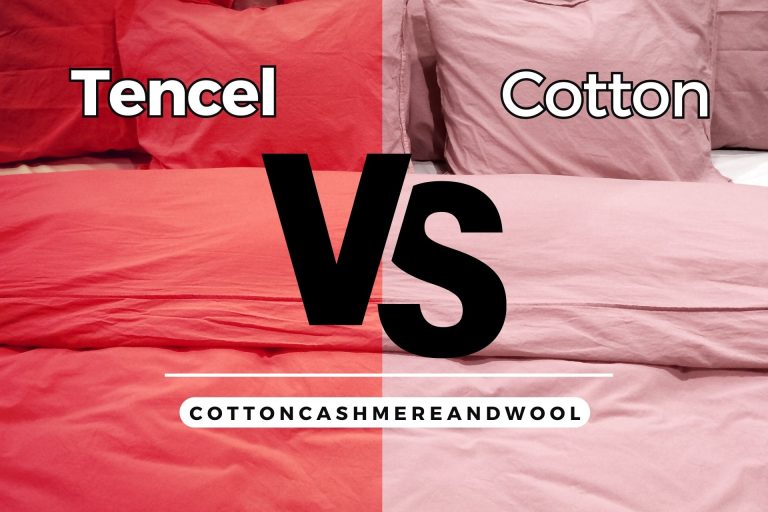In terms of clothes, the fabric you select may significantly affect your comfort, style, and even the environment. Tencel and cotton are two of the most widely used natural fabrics, each with its unique characteristics and benefits.
Are you torn between these two natural fibers, wondering which one truly suits your lifestyle and values? As you delve into this fabric face-off, prepare to uncover the secrets behind your most intimate decisions—because when it comes to Tencel and Cotton, it is not just about what you wear; it’s a reflection of the conscious consumer within you, navigating a world of choices with purpose and panache.
Table of Contents
Tencel: The Sustainable Choice

Tencel, also recognized as lyocell, is a sustainable fabric derived from wood pulp, mainly sourced from eucalyptus trees. Its production process involves minimal chemical use, making it environmentally friendly. Tencel is renowned for having a silky-smooth feel, being breathable, and having the capacity to drain away sweat, making it the perfect fabric for comfortable clothes.
Types of the Tencel:
Tencel is a versatile and sustainable fabric made from wood pulp, mainly sourced from eucalyptus trees. There are different types of Tencel, each designed for specific applications and preferences. Here are some common types of Tencel:
1. Tencel Lyocell:
This is the most common type of Tencel fabric. It is known for its silky smooth texture, breathability, and moisture-wicking properties. Tencel Lyocell is widely used in clothing such as dresses, shirts, and activewear. It is also used for bedding and home textiles.
2. Tencel Modal:
Tencel Modal is prized for its exceptional softness and ability to retain its shape after multiple washes. It is often blended with other fabrics, such as cotton or spandex, to enhance its stretch and durability. Tencel Modal is commonly found in underwear, loungewear, and casual wear.
3. Tencel Denim:
Tencel Denim is a variant specifically designed for denim clothing. It combines the sustainability of Tencel with the classic look and durability of denim. Tencel Denim is known for its comfortable fit and reduced environmental impact compared to traditional denim production.
4. Tencel Blends:
Tencel is often blended with other fibers like cotton, wool, or spandex to enhance certain characteristics. For example, Tencel-Cotton blends combine the softness of Tencel with the breathability of cotton.
5. Tencel Home Textiles:
Due to its ability to drain away moisture and breathe, Tencel is widely utilized in household textiles, including beds, towels, and curtains. Particularly renowned for their plush texture and softness is Tencel bedding.
Pros of Tencel:
-
Tencel is made utilizing environmentally friendly processes, with eucalyptus trees serving as the primary source of wood pulp. Compared to many other textiles, it has a lesser impact on the environment.
-
Tencel is known for its silky-smooth texture and excellent breathability, providing comfort in various climates.
-
Tencel is durable and resistant to wrinkles and shrinkage, resulting in longer-lasting garments.
-
Tencel is biodegradable, meaning it naturally decomposes without harming the environment.
-
Tencel is hypoallergenic, making it suitable for individuals with sensitive skin or allergies.
Cons of Tencel:
-
Tencel garments are often more expensive than those made from conventional cotton or synthetic fabrics due to the eco-friendly production process.
-
Tencel may require more delicate care, with specific washing and ironing instructions to maintain quality.
-
Tencel may have a somewhat limited color range compared to fabrics like cotton, as it may not accept dyes as easily.
-
Some Tencel fabrics are blended with other fibers, which can alter their characteristics. Consumers should check labels to understand the exact composition of Tencel blends.
Cotton: The Classic Option

Cotton, often referred to as “the fabric of our lives,” has been a staple in the textile industry for centuries. Cotton is a natural fiber known for its softness, breathability, and comfort, making it a popular choice for clothing and home textiles. Its appeal is due to its capacity to keep you warm in colder areas while keeping you cool in warmer climates.
Additionally, cotton’s absorbent properties make it ideal for bath towels and bed linens, ensuring a comfortable and cozy experience. Whether you’re seeking a classic, timeless fabric or simply appreciate its comfort and versatility, cotton remains a trusted favorite in the world of textiles.
Types of the Cotton:
Cotton is a versatile natural fiber, and there are several types of cotton known for their unique characteristics and uses. Here are some common types of cotton:
1. Upland Cotton:
This is the most extensively cultivated and utilized kind of cotton worldwide. Upland cotton is known for its medium-length fibers and is used in a wide range of textile products, including clothing, bed linens, and towels.
2. Pima Cotton:
Also known as extra-long-staple (ELS) cotton, Pima cotton is celebrated for its exceptionally long fibers. This type of cotton produces a soft and luxurious fabric with high durability. Pima cotton is often used in premium-quality clothing, luxury bedding, and high-end towels.
3. Supima Cotton:
Supima cotton is a trademarked name for American Pima cotton, known for its superior quality and length of fibers. It meets strict quality standards and is often used in luxury apparel and high-end home textiles.
4. Egyptian Cotton:
Grown in Egypt’s Nile River Valley, Egyptian cotton is world-renowned for its long and fine fibers. It produces an exceptionally soft and durable fabric, making it a preferred choice for luxury bed linens and high-quality clothing.
5. Sea Island Cotton:
This rare and highly prized type of cotton is known for its long, silky fibers. Sea Island cotton is primarily grown in the Caribbean and is used in premium clothing and luxury textiles.
Pros of Cotton:
-
In a variety of conditions, cotton is soft, breathable, and easy to wear.
-
It’s used for a wide range of products, from clothing to home textiles.
-
Cotton is a natural fiber and biodegrades easily, reducing environmental impact.
-
It’s generally well-tolerated by people with sensitive skin or allergies.
Cons of Cotton:
-
Cotton cultivation consumes a significant amount of water, which can strain local water resources.
-
Conventional cotton farming often involves heavy pesticide and chemical use, which can harm the environment and workers.
-
Cotton fabrics may shrink and wrinkle more than synthetic alternatives, requiring special care.
-
Cotton absorbs moisture yet may take longer to dry than other materials, increasing drying times.
Tencel vs. Cotton: A Comparison
Choosing between Tencel and cotton is a decision that revolves around several crucial factors, each with its own significance. In this comprehensive comparison, we’ll explore the factors, providing insights into how Tencel and cotton perform in each category. These insights will help you make an informed choice based on your preferences, values, and needs.
| Aspect | Tencel | Cotton |
|---|---|---|
| Source | Wood pulp, primarily from eucalyptus trees | Cotton plants |
| Sustainability | Highly sustainable, eco-friendly production process with reduced water usage and minimal chemical waste | It can be water-intensive and may involve pesticide use in conventional farming. |
| Comfort | Silky-smooth texture, excellent breathability, moisture-wicking properties | Soft and breathable, comfortable in various climates |
| Durability | Durable and resistant to wrinkles and shrinkage, longer-lasting garments | Durable but may require more care to prevent shrinkage and wrinkles |
| Moisture Absorption | Excellent moisture-wicking properties, keeping you dry | Good moisture absorption, but may feel damp in humid conditions |
| Biodegradability | Biodegradable, naturally decomposes without harming the environment | Biodegradable but synthetic dyes and finishes may slow down decomposition |
| Hypoallergenic | Hypoallergenic, suitable for sensitive skin or allergies | Generally well-tolerated, but may cause allergies in some individuals |
| Cost | Typically more expensive due to sustainable production methods | Generally more affordable, with some premium varieties being pricier |
| Versatility | Versatile for various products, from clothing to bedding | Versatile and widely used in a wide range of textile products |
| Care Requirements | It may require more delicate care, with specific washing and ironing instructions. | Easier to care for, withstands regular machine washing. |
| Color Range | Somewhat limited color range due to dye absorption characteristics. | Offers a wide range of colors due to easy dye acceptance. |
| Blending with Other Fibers | Often blended with other fibers, which can alter characteristics | It can be blended with other fibers for specific purposes |
Factors to Consider When Buying Tencel vs. Cotton Sheets:
Several considerations should influence your choice when buying sheets, whether they are made of cotton or Tencel, to ensure that you make the best choice possible for your requirements:
- Material Preference:
Consider whether you prefer the sustainability of Tencel or the classic comfort of cotton. Your choice will depend on your environmental concerns and personal comfort priorities.
- Thread Count:
Look at the thread count, which shows how many threads there are per square inch. In general, sheets with higher thread counts are softer and more durable. Extremely high thread counts, however, do not always indicate higher quality.
- Weave Type:
Sheets come in various weaves, such as percale, sateen, and twill. Each weave offers a different feel and texture, so choose one that matches your comfort preferences.
- Maintenance:
Think about the care requirements. Tencel sheets may require more delicate care, while cotton sheets are generally easier to maintain.
- Climate:
Consider your local climate when selecting sheets. Tencel sheets are known for their moisture-wicking properties and breathability, making them suitable for warm environments. Cotton sheets are versatile and can work well in various climates.
- Budget:
Take your budget into account. Tencel sheets are typically more expensive than cotton sheets due to their sustainable production methods. Determine what you’re willing to invest in your bedding.
Which is Better, Tencel or Cotton?

Whether Tencel is better than cotton depends on your specific needs and priorities. Tencel offers sustainability advantages due to its eco-friendly production process, while cotton boasts comfort and affordability. When deciding between the two, consider factors like environmental concerns, comfort, budget, and ease of care. Ultimately, the choice comes down to what aligns with your values and lifestyle.
Tencel Sheets Are Your Best Choice If:
-
You prioritize sustainability
-
You have sensitive skin or allergies
-
You prefer a silky-smooth feel
-
You want sheets with minimal wrinkles
Cotton Sheets Are Your Best Choice If:
-
You prioritize affordability
-
You desire a wide range of shades and designs.
-
You prefer a classic and versatile option
-
You prefer easy care
Frequently Asked Question:
What is Tencel, and how is it different from cotton?
A sustainable fabric called Tencel is created from wood pulp, typically from eucalyptus trees. Regarding comfort, maintenance needs, and sustainability, it differs from cotton.
Which type of sheets is better for hot and humid climates?
Tencel sheets are a popular choice for hot and humid climates due to their moisture-wicking and breathability properties.
Are Tencel sheets more eco-friendly than cotton sheets?
Yes, these are generally considered more eco-friendly due to their eco-friendly production process with reduced water and chemical usage.
Which sheets are more comfortable, cotton or Tencel?
Both are comfortable, but it depends on personal preference. Tencel is known for its silky feel and moisture-wicking properties, while cotton offers classic comfort and breathability.
Are there any specific care tips for maintaining the quality of cotton or Tencel sheets?
Follow the care instructions provided with the sheets. For Tencel, avoid high-temperature washing and ironing. For cotton, regular machine washing is generally acceptable.
Do Tencel sheets wrinkle less than cotton sheets?
Yes, Tencel sheets are known for their resistance to wrinkles, which can result in a neater appearance compared to cotton sheets.
Can I find organic cotton sheets for an eco-friendly option?
Yes, organic cotton sheets are available, offering a more sustainable cotton choice with reduced pesticide use.
Conclusion:
Tencel and Cotton are two fabrics that offer unique advantages and considerations. Tencel is eco-friendly and eco-friendly, offering comfort, durability, and hypoallergenic properties. It is suitable for those seeking both sustainability and comfort in clothing and textiles.
Cotton, on the other hand, is a classic, versatile, and budget-friendly choice. It is suitable for various climates and is generally more budget-friendly. However, its cultivation can be resource-intensive, and conventional farming practices may have environmental drawbacks.
The choice between Tencel and Cotton depends on personal preferences, values, and practical needs. Balancing these factors will help you choose the fabric that best suits your lifestyle.

